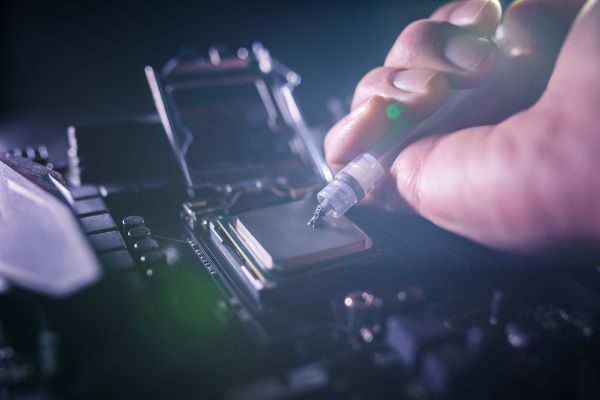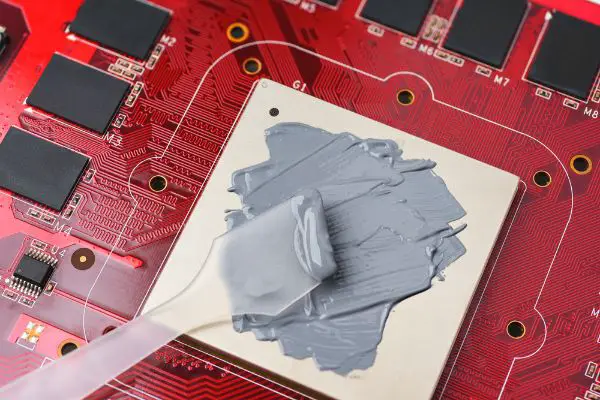Disclaimer: This post may contain affiliate links, meaning we get a small commission if you make a purchase through our links, at no cost to you. For more information, please visit our Disclaimer Page.
Thermal paste is a special product that one might use to keep their PC cool when it starts to heat up with use. A computer can get hot if it runs several intense processes, especially graphically intense programs. This article will discuss whether the thermal paste brand might make a noticeable difference in your computer’s temperature.

Table of Contents
Are All Thermal Pastes the Same?
Thermal paste is one of the preferred names for a substance intended to draw heat away from your CPU and transfer it to your heatsink. It’s known in gaming and other communities as a thermal interface material in the general sense.
You might also hear it called thermal grease or thermal gel, but all of these names refer to the same basic product. The true question is whether different kinds of thermal paste might function differently.
All thermal pastes are designed to perform the same function. However, different pastes consists of various mixes of compositions, effectiveness, viscosity, and price points. With this in mind, not all thermal pastes are the same, but deciding how they are different can be tricky.
Before we dig into things, there is an important point to consider. There are two main types of this paste. The first type will conduct electricity, but the second type will not.
Pastes that conduct electricity will have some metal components in them. These types tend to conduct heat better than their counterparts. However, it is also possible that the microscopic metal traces in these pastes could cause some damage to more sensitive electronic components.
Therefore, we recommend that newcomers to thermal paste or gels stick with the ceramic versions instead. Stick with this until you get a feel for how the pastes work.
Any group of enthusiasts will have their favorite thermal pastes. Still, the conductivity is one of the same differences everyone should be mindful of before trying to modify the existing paste inside their computers. The other things to be aware of are consistency and viscosity.
Sometimes, you may come across a thermal paste that is too similar to glue. When this happens, the paste might be too sticky to conduct heat well, and it will instead gum up the workings between the CPU and the heatsink. This is rare among thermal pastes, but it is still good to be aware of this possibility before purchasing anything as a newcomer.
Can You Use Any Thermal Paste On CPU?
Because CPUs run hot as they work, most manufacturers already have a paste, gel, or some cooling agent applied to the computers before they pack them up and ship them out. It would be unusual for any computer not to have some thermal paste applied already. While you can use any thermal paste on any CPU, we’ll issue a word of caution here with laptops.
1. Applying or reapply thermal paste to a laptop CPU is possible. However, you should only attempt this if your laptop is overheating badly, regularly, and with no indication of what else the problem might be.
2. Applying the paste to a laptop will require you to disassemble quite a bit of the laptop and open it up to the motherboard and other important, sensitive components. Generally, it is easier to work with the insides of a standard desktop than a laptop, so one should use caution when taking apart the latter.
3. With laptops, overheating can often be an issue with the fan more than the thermal paste. However, it is always possible that dried-out thermal paste is the issue.
4. You can still use any thermal paste of fair quality for a CPU in a laptop, but there could be issues in trying to replace it yourself. Laptops come with good thermal paste already installed, and you shouldn’t need to replace them unless there is an issue.
In short, it is recommended that you make sure that thermal paste is applied to the CPU of any computer. There are also ways to change the thermal paste on your laptop if necessary. You will find differing schools of thought on whether laptop thermal paste or gel should be reapplied.
Most of the time, you should be able to leave the thermal paste on your laptop alone unless there is a serious overheating issue not caused by the fan.
If you experience such problems with a laptop, it may be best to take the device to a professional for a look rather than taking it apart yourself. Doing this kind of maintenance on the laptop could void the warranty and make it harder to get repairs done if something goes wrong during disassembly.

Do Different Thermal Paste Brands Matter?
In most cases, different brands of thermal paste will use similar compositions to achieve the desired effect of keeping your PC cool. You may see slight differences, but these changes are essential only if you desire to overclock your system. For regular users, the differences of a few degrees should not matter too much.
Therefore, most thermal paste brands will do the trick nicely for newcomers or those who just want to ensure their CPU is taken care of well. If you’re new to thermal paste, check and see if you can figure out which brand or type the manufacturer used when putting together your computer.
Otherwise, you could ask for recommendations at any computer store or dedicated forum. As long as you’re careful, there shouldn’t be much of an issue in just trying out the thermal paste brand of your choice to see if you like it.
You may find groups of DIY enthusiasts who prefer one brand over another. In such cases, they may have tested extensively against multiple brands of thermal paste to find one that is perfect.
However, it is crucial to note that different system rigs might have different requirements with thermal paste or cooling. A standard, mid-range brand of thermal paste should serve your needs well, and you can always experiment to find a favorite brand later.
Is It OK To Use Cheap Thermal Paste?
It is perfectly fine to use an inexpensive thermal paste. You don’t need to break the bank on cooling agents like this when we have already outlined that many of the ones you’ll find are the market will function similarly, and you should see just a few degrees of difference between them.
As with many things in life, it is fine to go cheap when it comes to thermal paste, but not too cheap.
Thermal pastes that might be on the ultra-cheap end of the spectrum could dry out prematurely, meaning that you would need to reapply a square of paste more often than you’d think.
While this isn’t guaranteed, the compositions in the very cheap pastes might mean that you’re getting a somewhat shorter shelf life with your product.
Most thermal pastes that are at least adequate are not very expensive, so it makes sense to invest in something a bit better to protect the life of your computer and save you some hassle.
Another possible issue with the cheaper materials is that it may not cool things down adequately. The last thing you want is to go through all the trouble of reapplying thermal paste and putting everything back together to find that your CPU is still overheating.
In that case, you might miss that the problem is related to thermal paste and start looking for unnecessary, complicated solutions. You want something that will keep things cool and last for a few years. In short, it is acceptable to use cheap thermal paste. Just ensure it is a good, mid-range option.
While this is not an issue of thermal paste quality, we should note that you can purchase both general and computer-specific thermal paste. We recommend you purchase thermal paste designed for use inside a computer to get the best results for CPU cooling.
The Bottom Line
For the most part, the brand of thermal paste you choose for your computer won’t make a major difference. Just having a thermal paste square with decent cooling properties applied at all is what is most important here.
As long as the paste is not too cheap, doesn’t have any particles in it that could harm the more sensitive portions of your computer, and is applied correctly, you should be fine. With proper thermal paste application, your CPU should be happy for years.
